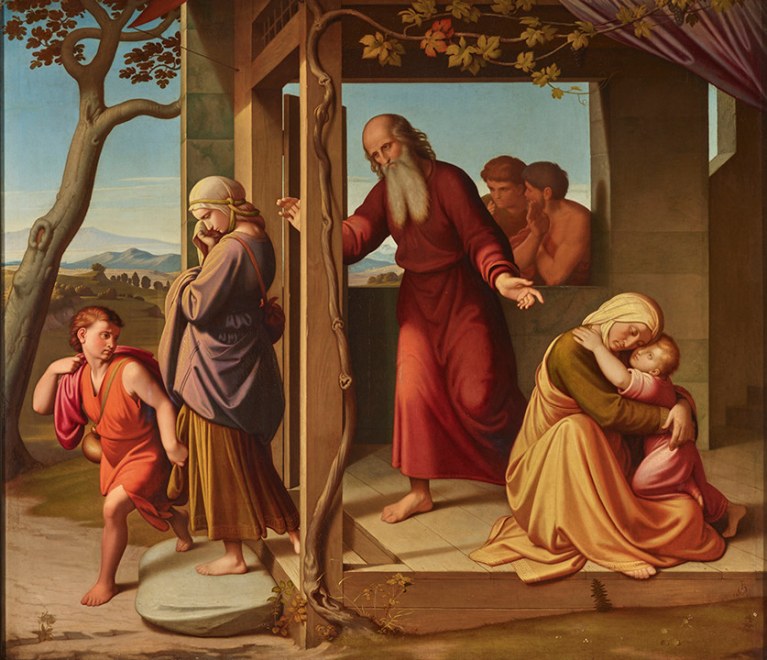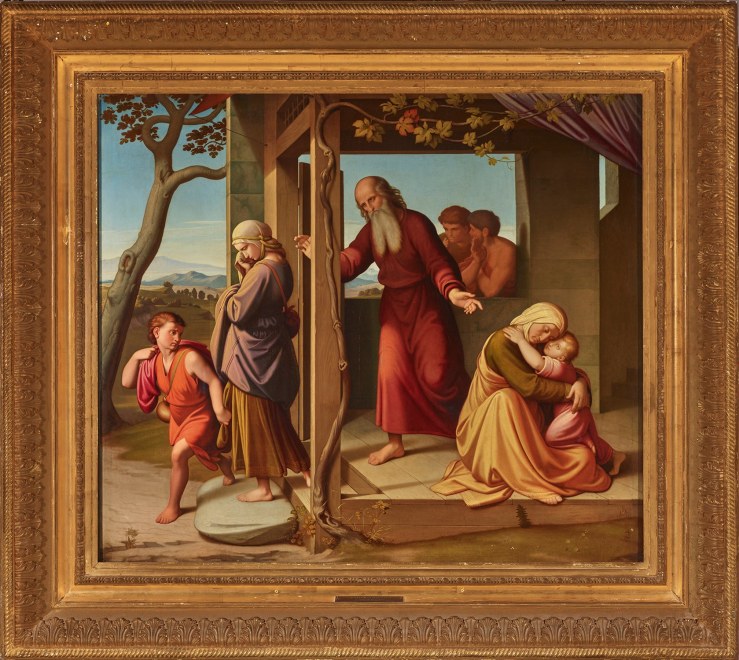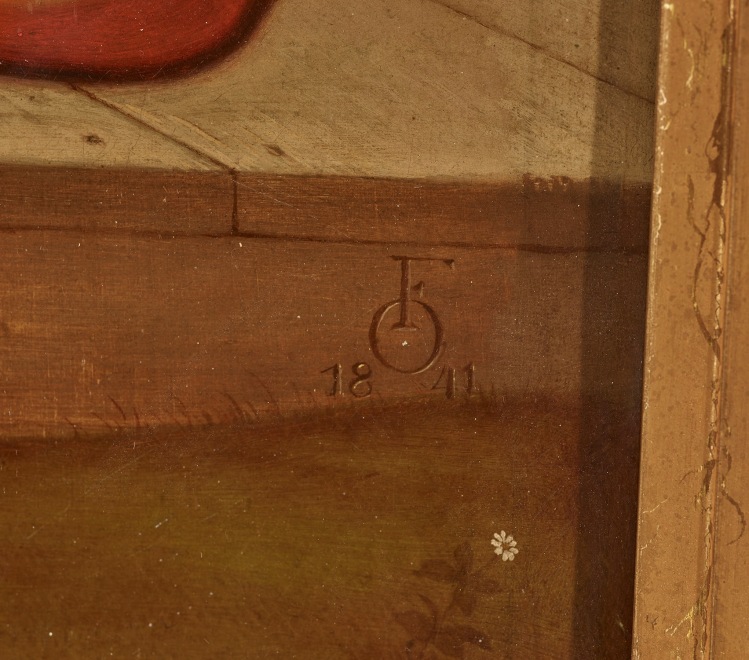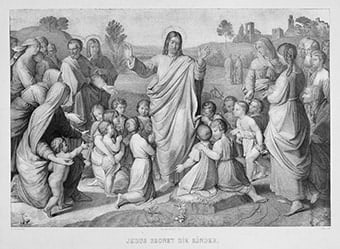Provenance
Martin Johann Jenisch the Younger, Hamburg, 1841 (commissioned from the artist by 1830)
Thence by descent, Holland (and sold: Christie’s, London, 13 December 2016, lot 11)
Private collection, California (acquired at the above sale)Exhibited
Lübeck, Benhaus Estate, Overbeck und sein Kreis, 1926, no. 231, p. 141
Altonaer Museum, Hamburg, 1971 (on permanent loan from Johann Freiherr von Jenisch)
Hamburg, Altonaer Museum, Die Gemäldesammlung des hamburgischen Senators Martin Johann Jenisch D. J. (1793-1857), 4 July -2 September, 1973, no. 39, pp. 27, 64
Rome, Valle Giulia, Galleria Nazionale d'Arte Moderna, Nazareni a Roma, 22 January-22 March 1981, no. 83, p. 130
Lübeck, Benhaus Estate, Johann Friedrich Overbeck 1789–1869. Zur zweihundertsten Wiederkehr seines Geburtstages, 25 June-3 September 1989, no.28, p. 152
Literature
Erwin Speckter, Briefe eines deutschen Künstlers aus Italien, vol.1, Hamburg, F. A. Brockhaus, 1846, p. 120
Franz Kugler, “Fragmentarisches über die Berliner Kunstausstellung vom Jahr 1836 [first in Museum, 1836, nos. 39 ff.]“, in Kugler, Kleine Schriften und Studien zur Kunstgeschichte, Stuttgart, Ebner & Seubert, vol. 3, 1854, p. 177
Margaret Howitt and Franz Binder, Friedrich Overbeck. Sein Leben und Schaffen, Bern, 1886, vol. 1, pp. 139-143 and vol. 2, p. 421
Friedrich von Boetticher, Malerwerke des neunzehnten Jahrhunderts: Beitrag zur Kunstgeschichte, Dresden, Boetticher, 1891-1901, vol. II (1898), no. 31, p. 200Kurt Eberlein and Karl Heise, Die Malerei der deutschen Romantiker und Nazarener: Im besonderen Overbecks und seines Kreises, Munich, Wolff, 1928, no. 16.
Cordula Grewe, “The Invention of Secular Devotion,“ in World & Image, vol. 16, no. 1, Jan. March, 2000, p. 53, ill.
Michael Thimann, “Hieroglyphen der Trauer: Johann Friedrich Overbecks ‘Beweinung Christi’,” Marburger Jahrbuch für Kunstwissenschaft 28, 2001, p.195, 219 (endnote 29)
Catalogue note
At the height of his fame and artistic power, Johann Friedrich Overbeck turned to a theme of immense popularity in 19th-century Europe: the expulsion of Hagar and her son Ishmael from the house of Abraham (Genesis 21:14). The finished canvas would be exceptional for several reason. For one, it is one of his few biblical histories executed in oil. On the other, it lives off a poetic mood hardly found in any other painting by the artist. At the same time, the canvas embodies some of Overbeck’s most cherished characteristics, such as a calm, contemplative interiority triumphant over the intense emotional charge of the biblical source.
The expulsion seems to take place almost silently, the figures animated by a peculiar devotion, the biblical landscape in the background glowing in an expert old-masterly sfumato. With the picture’s future destination in mind, the private collection of a wealthy Hamburg client, Overbeck settled on a typical gallery format, skillfully using the transverse rectangle to tell the tale via the figures’ arrangement and gestures. Overbeck set a powerful tone of resistance, to fate and the viewer’s gaze alike, by having Hagar and Ishmael move to the left, away from the house, and thus against our reading direction. In a countermove, the same play with our conventional reading direction assumes a conciliatory tone as it continues in the gesture of Abraham’s left arm. The patriarch points to his wife, Sarah, crouching on the ground with Isaac, the boy she had born at ninety years old, in her arms. Having just created a clear contrast of the two groups, Overbeck, a Catholic convert himself, now transforms the Romantic program of the Lukasbund’s early days into a fundamental confessional decision. Hagar’s banishment becomes a typological image in which the replacement of the Old by the New Covenant is at stake. The symbolism of plants—the fig tree as a sign for the nation of Israel, the vine a symbol of Christ’s Passion—articulate this Supersessionist program as clearly as the allusion to a Madonna with Child in the image of Sarah and her son. Probably based on the scene’s (re)interpretation by Paul (Galatians 4:21-24), Overbeck thus presented the story of Hagar, Sarah, Abraham and their children as a parable of the two testaments, of Ecclesia and Synagogue.
The canvas, without question a major work not only vis-à-vis Overbeck’s production, but late Romantic painting as well, had a long gestation time. Its origins go all the way back to a studio visit in 1830 by Martin Johann Jenisch the Younger (1793-1857), a wealthy merchant and influential senator in Hamburg. The previous year, Jenisch and his wife had embarked on the Grand Tour, mandatory for all of Europe’s High Society, with their minds set less on education but desirable purchases. Naturally, a work by a leading Nazarene could not be missing from their list, and as soon as they reached Rome, the couple approached, predictably, Overbeck. For once, the painter happily accepted the commission, but things soon got off to a difficult start. Overbeck refused to send the senator a compositional sketch because, as he told Jenisch, foreign judgment would disturb and inhibit him. In 1834, the cartoon was finally ready and exhibited two years later at the biannual exhibition of the Berlin Academy; but, the picture itself was still a long time coming. Only when Jenisch returned a second time to Rome in 1838 and reiterated his desire (and claim), did Overbeck return to Hagar’s Banishment and finally completed it in 1841. Once in Hamburg, the canvas immediately assumed a place of pride among the over 100 paintings which by then adorned the Jenischs’s newly built country house, a marvel of Neoclassicalarchitecture with an exquisite, rather Romantic view over the Elbe. Finished in 1834, the same year as Härtel’s Roman House in Leipzig (see Cat. 7), this villa suburbana had miraculously escaped the bombings of World War II and today, with much of its original interior intact, affords the visitor a vivid impression of the grand lives led by well-to-do Hanseatic merchants in the middle of the 19th century. At the same time, the location of the house and collection mattered beyond the confines of the city’s own haute volée. Overbeck’s decision to stay in Rome had resulted in a notably international clientele, which, in turn, meant that his work was scattered across the globe. For that reason, Hagar’s Banishment occupied a special role in Germany, where it was one of the few oil paintings by Overbeck to be seen in the original.
One final word: The Banishment of Hagar is unquestionably one of the most important works by Johann Friedrich Overbeck that has appeared on the art market for decades. Paintings by Overbeck are extremely rare, as he executed only a few works in oil and most of these are now owned by German museums and thus never again for sale. Equally unusual is the picture’s impressive provenance. Not only did it remain in the same collection, started by Jenisch, for more than 150 years. This collection itself is among the few private painting collections amassed in 19th-century Germany that have come down to us mostly intact. As such, The Banishment of Hagar is among the most unique, and perhaps among the rarest, pieces of High Romanticism, sold in the 21st century.
Cat. 8 Figures
Cat. 8a S. Maier, after Johann Friedrich Overbeck, Christ Blessing the Children, after 1826, lithograph, 38.7 x 56.7 cm. Printed in Paris by Lemercier & Cie, Gallerie. Publisher J. Velten in Carlsruhe, Bassenge, Berlin.








